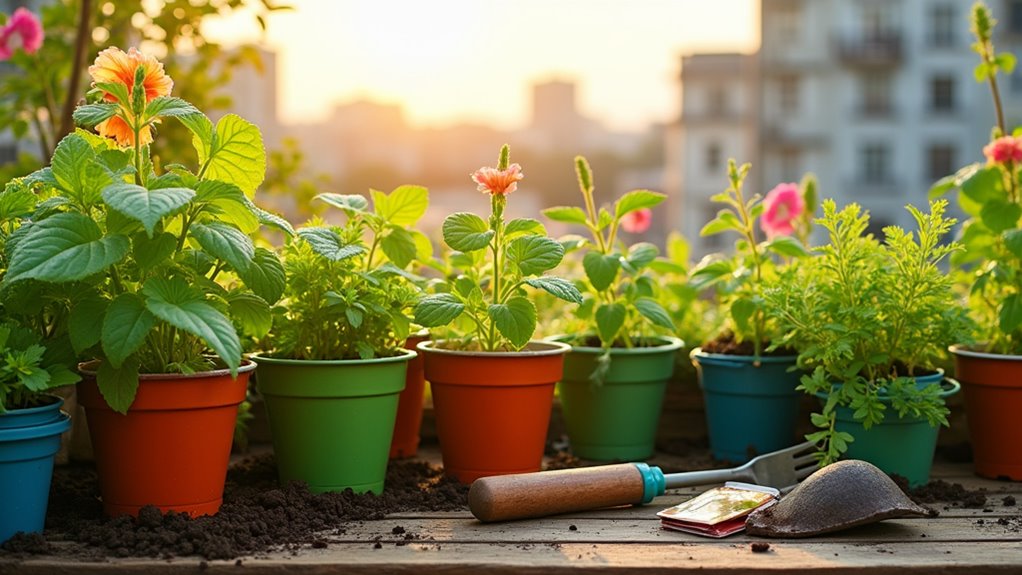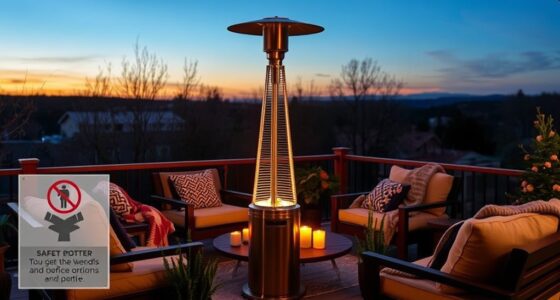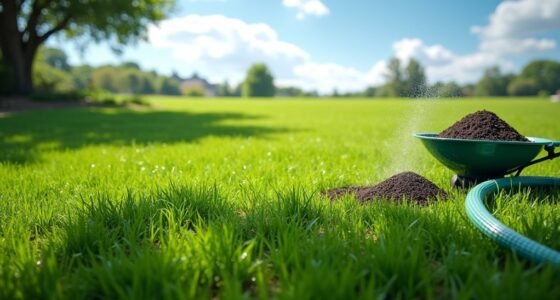Container gardening lets you grow vegetables, herbs, or flowers in limited spaces, making it perfect for urban living. You’ll want to choose containers with drainage holes and use quality potting soil. Opt for dwarf plants and group them by their sunlight needs. Keep the soil moist and provide regular fertilization. Watch out for pests! If you want to discover more tips and tricks for successful container gardening, keep going to learn how to get the most from your garden.
Key Takeaways
- Choose containers with adequate drainage holes and ensure they are made from food-safe materials like plastic or ceramic.
- Use high-quality, soilless potting mix to promote better drainage and root growth.
- Select dwarf or bush varieties of plants suitable for limited space and ensure pots are at least 12 inches deep.
- Water plants daily, especially during hot weather, to keep the soil consistently moist.
- Regularly fertilize every few weeks with organic fertilizer to replenish nutrients in the soil.
What Is Container Gardening?
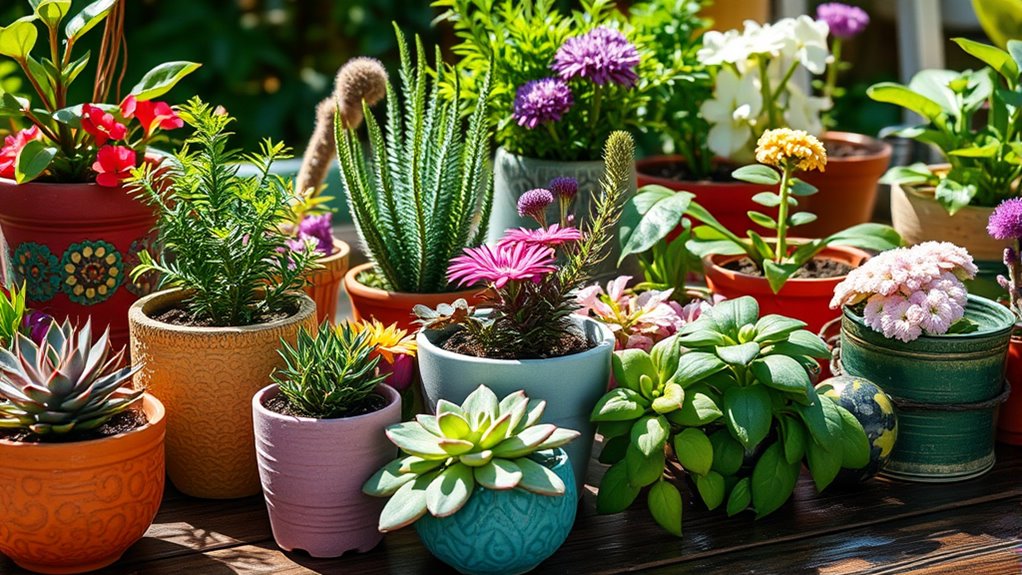
Container gardening is a versatile way to grow plants, whether you’re interested in vegetables, herbs, or flowers. This method involves using containers to cultivate your plants, making it perfect for those with limited space or poor soil conditions.
You can easily move your containers to guarantee they receive ideal sunlight and protection from harsh weather. Most vegetables thrive in containers with at least 12 inches of soil depth, while larger plants like tomatoes need a 5-gallon container for successful growth.
Using a high-quality, soilless potting mix is essential, as it provides better drainage than traditional garden soil. This approach reduces weeds and allows you to control soil quality and nutrients, making your gardening experience more manageable and enjoyable.
Benefits of Container Gardening

Container gardening is perfect for limited spaces, especially in urban environments where traditional gardening isn’t feasible. You’ll enjoy the flexibility of moving your containers to optimize sunlight and protect your plants from harsh weather. Additionally, portable gardening solutions can cater to your specific needs, making it easier to create a thriving garden in any location. This method aligns well with the concept of a backyard greenhouse, as it allows you to extend your growing season while maximizing space. Incorporating greenhouse techniques can further enhance your container gardening success by providing an ideal growing environment.
Container gardening is ideal for urban spaces, offering flexibility to optimize sunlight and shield plants from the elements.
This method also allows you to maintain better soil quality, as you can use specialized potting mixes tailored to your plants’ needs. Plus, you’ll face fewer weeds, leading to less maintenance and more focus on your desired plants.
- Elevated containers improve accessibility and reduce soil-borne diseases.
- You’ll experience healthier plant growth.
- Gardening becomes easier with less weeding.
- It’s a great way to enhance small spaces.
- Additionally, container gardening can help promote sustainable practices by allowing you to choose eco-friendly materials and methods.
Choosing the Right Containers and Soil

Selecting the right containers and soil is essential for maximizing your container gardening success.
When choosing the right containers, make certain they’ve adequate drainage holes to prevent water retention that can lead to root rot. Opt for pots made from food-safe materials like plastic, ceramic, or fabric, which provide good moisture retention and aeration for healthy plant growth. Additionally, consider how certain plants may thrive in haunted places where mysterious energy may influence their growth. Choosing materials that are non-toxic ensures a safe environment for both plants and gardeners. Using your imagination in designing your garden layout can lead to creative plant arrangements that enhance both aesthetics and plant health.
Pay attention to pot sizes; larger plants like tomatoes need at least a 5-gallon container, while herbs thrive in 2-3 gallon pots.
Use high-quality potting soil specifically designed for container gardening; it’s lightweight and drains well, promoting root growth.
Avoid the misconception of adding rocks for drainage, as it can actually hinder proper drainage conditions for your plants. Additionally, ensure that your pots have drainage holes to prevent waterlogging and support healthy root development.
Selecting and Caring for Container Vegetables

When it comes to container vegetables, choosing the right varieties can make all the difference in your gardening success. Opt for dwarf or bush varieties like tomatoes and peppers, as they’re perfect for limited spaces. Additionally, consider using energy-efficient stoves that can complement your gardening setup by providing warmth during cooler months. It’s also important to locate water sources nearby for easy access to hydration for your plants. For optimal results, you might also explore best lifestyle products that can enhance your gardening experience.
Ascertain your containers have at least 12 inches of soil depth, with larger plants thriving in 5-gallon pots.
To care for your container vegetables, remember to:
Caring for your container vegetables involves grouping plants wisely, watering daily, and regularly fertilizing for optimal growth.
- Group plants with similar sunlight and moisture needs.
- Water daily, especially during hot weather, to keep them hydrated.
- Fertilize every few weeks with a balanced, organic fertilizer.
- Monitor soil moisture levels to prevent drying out. Additionally, ensure your soil is well-drained and rich in organic matter to support healthy growth.
Common Challenges in Container Gardening
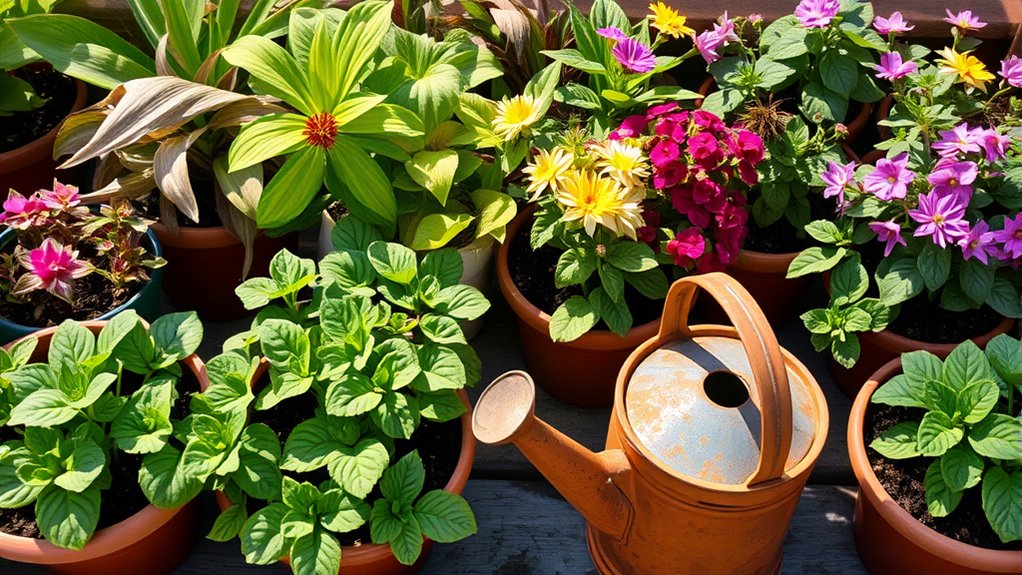
Container gardening offers a fantastic way to cultivate fresh vegetables, but it also comes with its own set of challenges.
You’ll need to be prepared for frequent watering, as soil dries out rapidly, especially in hot weather. Limited root space can hinder healthy root growth, so choose appropriately sized pots for your plants. Additionally, incorporating nutrient-rich soil can support the healthy growth of your container plants. Ensuring that your plants receive a balance of protein, fiber, and healthy fats through proper fertilization can further enhance their growth and productivity. Incorporating raw food diets into your gardening strategy can encourage you to grow a variety of fresh vegetables and fruits.
Pest management is vital, as container plants are just as susceptible to pests and diseases as those in the ground. Ongoing fertilization is necessary, since nutrients deplete quickly; using a mix of slow-release fertilizer and liquid feed can help.
Additionally, overcrowding your containers leads to competition for resources, stunting growth. Careful planning of plant combinations will guarantee ideal soil health and thriving plants. Incorporating composting techniques can enhance soil quality and provide essential nutrients for your container garden.
Frequently Asked Questions
How Do You Start a Container Garden for Beginners?
To start a container garden, pick containers with drainage holes and choose the right size for your plants.
Use a high-quality, soilless potting mix for better drainage.
Find a sunny spot that gets 6-8 hours of direct sunlight daily.
Water your plants frequently, checking the soil moisture regularly.
Finally, add slow-release fertilizers to your mix and use liquid fertilizers biweekly during growth to keep your plants healthy and thriving.
What Is the Most Common Mistake Made With Container Plants?
The most common mistake you make with container plants is using regular garden soil instead of a lightweight, well-draining potting mix. This can lead to poor drainage and root rot.
You’re also likely to choose pots that are either too small or too big, affecting your plants’ growth and moisture levels.
Don’t forget to guarantee your containers have adequate drainage holes, and always check the watering needs of your plants regularly.
What Is the Rule of Thumb for Container Gardening?
You might think container gardening is too complicated, but it’s simpler than you think.
The rule of thumb is to choose a container that’s at least 12 inches deep for most vegetables. For bigger plants like tomatoes or squash, go for containers of at least 5 gallons.
Always group plants with similar needs together and make sure your containers have drainage holes.
Frequent watering, especially in hot weather, keeps your plants thriving.
What Do You Put in the Bottom of a Container Garden?
When you’re setting up a container garden, skip the rocks or gravel at the bottom.
Instead, focus on using a high-quality potting mix that allows for proper drainage and aeration. You can place a coffee filter or landscaping fabric over the drainage holes to keep soil in while letting water escape.
Elevating your containers on pot feet or bricks will also help guarantee that drainage holes remain unobstructed for ideal moisture management.
Conclusion
In container gardening, you’re not just growing plants; you’re cultivating a little piece of paradise right at home. With the right containers, soil, and care, you can watch your vegetables thrive like stars under a summer sky. Don’t let challenges deter you; each hurdle is just a stepping stone to a bountiful harvest. So grab your pots, roll up your sleeves, and immerse yourself in the joy of growing your own food—it’s a rewarding journey worth taking!
